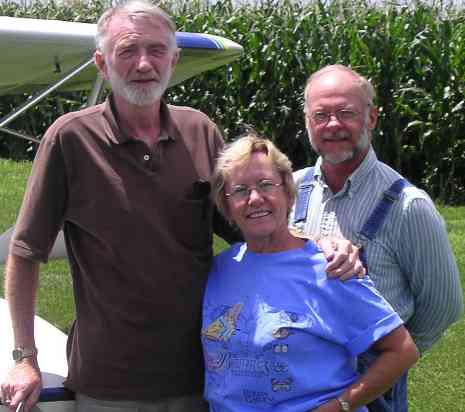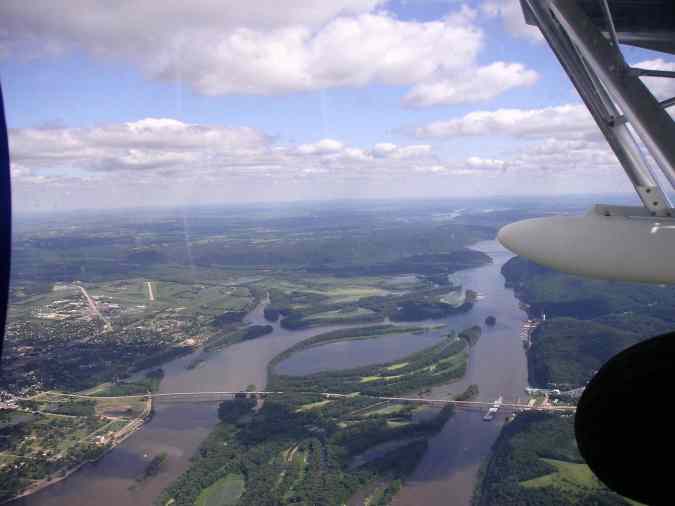Lesson 296-342 (a.k.a. N123XM flying hours)
July 23 - August 13
2400 nautical miles
2760 statute miles
+ many local flights
= 45.8 hours of flying
2005 SeaRey
Trip
to the
Midwest
Oshkosh
Georgian Bay
Hammondsport,
NY
Part 1
The morning of Saturday, 23 July
2005, looked good for beginning a trip
to visit a friend in Illinois and a cousin in Iowa and Oshkosh and
a SeaRey
bunch in Ontario.
I was somewhat anxious about the first part of
the trip--crossing the Appalachian Mountains--because a similar
crossing last year was mostly scud-running in low clouds for 150 miles,
trusting the altimeter to keep me clear of obscured ridges, and I
wasn't eager to repeat that exercise at. all. This year the weather
was more favorable, but there had been a few last-minute maintenance
problems to attend to. Finally, the airplane and the weather both
were ready. In order to arrive at Oshkosh in time and still have
good visits along the way, the first day was going to be a long
one--from Richmond, Virginia, to the Missippi River. Here are
some of the highlights.
Technically, the Great Smoky
Mountains were south of my route, but the
mountains near the Virginia-West Virginia state line looked rather
smoky anyway--only it was clouds, not smoke.
Not many level places to land
there. Except here--maybe. (I
didn't try, but was tempted.)
The first stop, after about 3
hours, was for GAS--that is, for gasolene
at KGAS, Gallia-Meigs Field, Gallipolis, Ohio. (They say
gal-uh-po-LEESE there.) This was my first view of the place as I
followed the river west to its confluence with the Ohio.
From the air it's easy to tell
which waterways are well cared
for. The Ohio River is a lot clearer than the.Kanawha.
The runway at GAS lies parallel to
the Ohio, on the west bank and just
this side of where a highway cuts diagonally through a hill.
And this is the view from the
other side:
I discovered that when I got down
to pattern altitude and turned onto
the downwind leg for runway 05, the airport disappeared behind the hill
until I was almost ready to turn final. It was almost like
mountain flying.
A dam and lock on the Ohio, near
Cincinnati:
Southwest of Cincinnati I circled
the house of another SeaRey owner,
Bob Toerner, and the marina where he ties the airplane down. ("WP
2" on the map above.) You
might just see his white SeaRey on the grass, near the middle.
No time that day for hanging
around, though. I did a
splash-and-go on the Ohio in front of Bob's house and then turned west
again, hoping to reach Quincy, Illinois, before dark. Arrived
there about half an hour past sunset, after flying the last two hours
into the setting sun that lit up the hazy sky and turned it
translucent, like skim milk, so that I had to look almost straight down
just to stay rightside up.
Here's the guy I visited there,
Terry Henert, a pilot and dentist, playing catch with his
talented dog, Peanut:
At first I thought she was
bouncing the ball with her nose, but another
photo showed that she bites at
it. She's been winning all sorts
of titles and accolades at dog trials all over the Midwest.
Next stop was my cousin Peggy and
her family, on their farm west of
Fort Dodge, Iowa.
Their place is the one on this
side--the south side--of the road.
The actual farm is... well, there's a whole lot of it--something like a whole
section, or more. (A section is one square mile.)
 Here's Peggy and
Gordon, in front
of their neighbor Gene Black's hangar.
Here's Peggy and
Gordon, in front
of their neighbor Gene Black's hangar.
Gene Black kindly consented to let
me land on his 2000 x 60 foot grass
airstrip, and kept my SeaRey safe from a storm in his huge "machine
shed." (It takes huge sheds to house the huge farm
machines.) Gene's runway is N-S and is surrounded on two and a
half sides by cornfields. He said that the wind wouldn't be any
problem down below the top of the corn. And that was so--the corn
was about 10 feet tall.
Here's how Google Earth sees it:

Here are Peggy and Gordon and
family--some of them--at home:
I could have stayed there forever
(well, okay, make that "forever"--but
I really enjoyed it). Peggy is the middle daughter of my favorite
aunt and uncle (my father's brother) and visiting her was like going
home again. But Oshkosh had already begun, and it was
time to head for the Seaplane Base there. First, though, there
was a morning of SeaRey rides, with water landings and photo ops of the
Chalstrom families' farms. Here's Peggy and Gordon's elder son,
Bryan, thinking of getting back into flying--and looking the part:
He did most of the flying to that
lake and back and seemed to be enjoying it.
With mixed feelings, I took off
from Gene Black's lovely green airstrip
one last time...

...and turned east northeast, toward Oshkosh, Wisconsin.
You might think that all they grow
in Iowa is corn--yes?
Not so. They also grow
propellers!
And they like modern art:
Looking south at Prarie Du Chien.

What has five eyes
and runs south?
(It's a terrible old
joke--and one of my favorites. The photo contains a hint.)
In good time I arrived at the
Oshkosh Seaplane Base. The
volunteers unloaded the SeaRey at the new U-shaped dock 4--all my
camping gear, my pack,
and my flight bag--and then towed the airplane out to a buoy in the
lagoon.
If you've never been to
Oshkosh--well, I'm not about to try showing you
what it's like here. I camped four nights at the Seaplane Base,
rode the shuttle bus to the main field in the morning and back late in
the afternoon, after the daily airshow. I'd been there two times
before. And I still
haven't seen the half of it.
Oshkosh is all airplanes. (Except
for the several-hundred-thousand
people who show up every day all week.) I looked at airplanes,
watched airplanes, sat in airplanes, talked airplanes, dreamt
airplanes--all of that and more. Here are pictures of only three:
A P-40, the fighter flown early in
WW II by the Flying Tigers, the
Tuskegee Airmen, and many other US and allied pilots. I had a
gleaming red plastic model of one when I was a kid at that time.
This is Molt Taylor's
Aircar. It really flew, if you spread out
the wings and tail and fastened them on. Without them, it was a
four-passenger car. More or less. But it was heavy and
slow, both in the air and on the road. Neat, though!
SpaceShipOne was there, too.
I
was surprised to see that despite Burt
Rutan's clever shuttlecock maneuver for re-entering the atmosphere, the
paint still burnt off the nose.
Okay, so much for Oshkosh.
Here endeth Part The First.
The next part of the trip took me to the north, to the east, and back
to the south.
Go
directly to Part 2. (Opens in its own window. This
window will stay open, too, to economize on bandwidth.)
Or...
Back
to "Learning Flying"
My home page
.